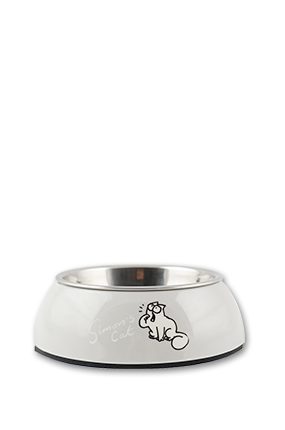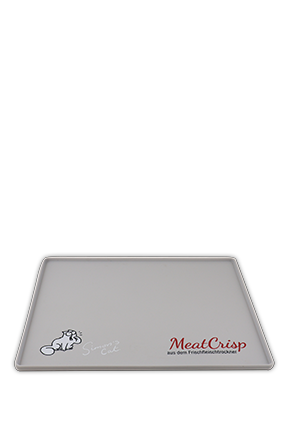What is the ideal weight for a cat?
How much should a cat weigh?
Excess weight in cats is just as unhealthy as being underweight, and can lead to long-term health problems for our feline friends. But how do I determine whether my cat is at a normal weight or whether it is too thin or too fat? When researching the ideal weight for a cat, you will often come across weight tables with different specifications, which adds to the confusion. Blanket statements setting the optimum weight for a cat are difficult, as there are many individual factors to consider. The cat’s breed and thus its size play a major role in determining ideal weight. After all, ideal weight will vary significantly between a normal domestic cat, a British Shorthair and a Maine Coon.
Before you can determine whether your cat is underweight, a normal weight or overweight, you first need to know exactly how much your cat weighs.
How to weigh a cat?
Weighing cats on a normal bathroom scale can be difficult. Our furry friends will not usually sit still wherever you put them. For kittens and young cats in particular, weighing on a normal scale is a special challenge. The method of weighing yourself with and without the cat and working out the cat’s weight by calculating the difference is only possible in the kilo range, depending on the scale. The weight in grams, which is especially important for growing cats, is often inaccurate on the scales used for people. To weigh kittens or young cats, a more accurate scale, such as a kitchen scale, is more suitable. You can also use a deep bowl or small basket in which you can weigh the kitten.
One trick that works for both kittens and playful cats is to lure them with a toy. To do this, slowly lead your cat onto the scale. Then hold the toy slightly above their head so that they linger on the scale. Whether your cat is standing or sitting makes no difference, as long as all parts of its body are on the scale. Special treat mats are also very useful for this purpose. These can be attached to a tiled wall in front of the scale and used to keep the cat calm on the scale.
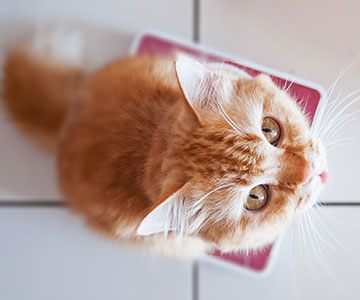 Wie wiegt man eine Katze am besten?
Wie wiegt man eine Katze am besten?
How heavy should a female cat be, and how much should a tomcat weigh?
Yes, there are also sex-specific differences in the ideal weight of cats. In order to judge whether you pet is over- or underweight, you must therefore also take sex into account. For weight data in guide tables, a distinction should always be made between the two sexes.
Weight table for females and males in kg*
| Breed | Weight female cat in kg |
Weight male cat in kg |
|---|---|---|
| Abyssinian cat |
2,5 - 4 | 3,5 - 5 |
| Bengal cat | 3 - 4 | 4 - 6 |
| British Shorthair |
4 - 5 | 5 - 6 |
| Burmese cat | 4 - 4,5 | 5 - 6 |
| German Longhair | 3,5 - 5 | 5 - 7 |
| Devon Rex cat | 2,5 - 3,5 | 3,5 - 4,5 |
| European Shorthair | 4 - 5 | 5 - 7 |
| Birman cat |
4 - 5 | 5 - 7 |
| Maine Coon | 4,5 - 6 | 6 - 10 |
| Mixed breed cat Shorthair | 3 - 4 | 4 - 5 |
| Norwegian Forest Cat | 3,5 - 7 | 5 - 9,5 |
| Ragdoll cat | 4,5 - 6,5 | 6,5 - 9,5 |
| Siamese cat |
3 - 4 | 4 - 5 |
| Turkish Angora cat |
2,5 - 4 | 3,5 - 5 |
* The table contains guide values which may vary on an individual basis and therefore serve only as a rough source of orientation.
Is my cat overweight and when is a cat too thin?
Compare your cat’s weight against the guideline values in weight tables for cats to get a first impression as to whether your cat is over- or underweight. Usually, a cat that is underweight or weighs too little will be a particularly fussy eater or will be ill. A more common problem is a cat that weighs too much and is therefore no longer a normal weight.
In order to be able to estimate even more accurately whether your cat is at the ideal weight, a visual and tactile check can be used in addition to weighing.
To perform such a check, ensure your cat is standing so that you can see the flow of the abdominal line from the side. A view from above can also be very helpful to see if your cat is underweight, an ideal weight or overweight.
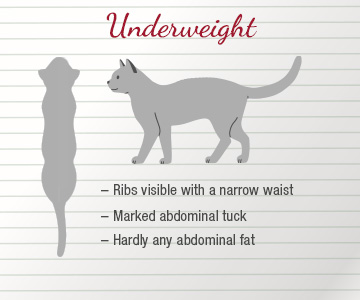
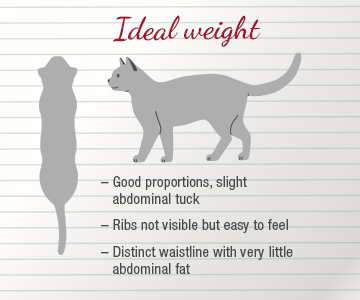
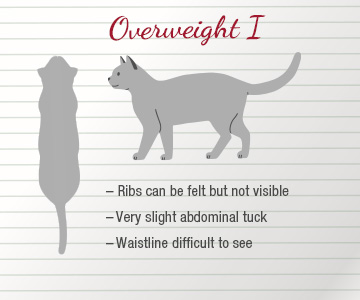
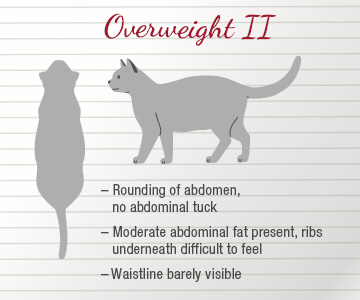
As you can see in the illustrations, the transitions are sometimes fluid. As a result, overweight cats are often not recognised as such by their owners. If you are unsure as to whether your cat is at an ideal weight or overweight, you can always contact your trusted vet to have their weight assessed. If the cat’s diet is not changed, obesity can lead to long-term health problems.
Reasons for excess weight in cats
Food and nutrition: Too much energy intake
A common reason for obesity in cats is too much energy intake. This can occur when cats are given unrestricted access to their cat food, and their daily portions are not rationed. It is important for the cat’s health that it can eat regularly, but the total daily amount should correspond to the cat’s calorie requirement and not exceed it. Just like in humans, this leads to excess energy being stored in fat deposits. When determining the amount of feed your cat needs each day, you should also take into account any snacks your cat receives in between meals. This is because treats, in particular, can have a high energy density, leading to excess calories in addition to normal cat food.
Too little exercise, low energy requirement
People who move a lot burn more calories. It’s no different for our house pets. Your cat’s energy requirements are influenced not only by its living situation – such as whether it is an exclusively indoor cat or a cat with outdoor access – but also by its age. Young cats up to around 2 years of age usually have the highest energy requirements, but these requirements decrease as cats get older. This should also be taken into account when working out the amount of daily feed. A cat food with a lower calorie content can be useful for older or less active cats.
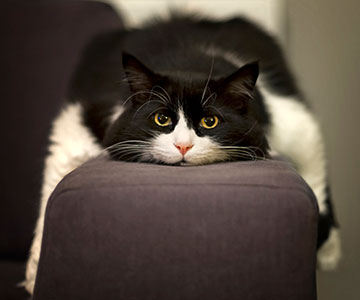 Wenig Bewegung kann auch bei Katzen zu Übergewicht führen.
Wenig Bewegung kann auch bei Katzen zu Übergewicht führen.
Neutering in cats can lead to weight gain
Neutering in cats can also lead to weight gain. Often, neutered cats have an increased appetite and tend to move around a little less than before. If their feed amount remains the same, this can lead to an increase in body fat and cause your cat to become overweight. If you have observed this in your cat or observe it after neutering, it is recommended to switch to a special cat food for neutered or spayed cats.
How do I make my cat slim again?
Generally, a cat on a diet should lose around 1 to 3 % of its body weight per week. The higher the cat’s weight, the slower they should lose weight; otherwise, they could be at risk of developing liver disease.
Important: You should never force your cat to have fasting days!
Fasting is particularly dangerous for overweight cats. As soon as your cat is without food, its body will look for a way to provide energy. This will then be pulled out of the fat stores. While this sounds good at first, it is dangerous for your cat because fasting simultaneously causes a protein deficiency with serious consequences for the liver’s metabolism. Too much fat gets into the liver and as a result it becomes “flooded” and is no longer able to function properly. This problem is called “secondary hepatic lipidosis” and is normally fatal if the cat does not receive the appropriate intensive medical treatment.
It is therefore advisable to discuss a plan to slowly reduce your cat’s food intake in consultation with your vet. Once the daily feed amount for a slow reduction in weight has been calculated, it is important to weigh this out daily and stick to it. Be sure to count any snacks and treats in between!
In the case of cats with outdoor access, it is more difficult to control food intake, as other food sources may also be present:
- A filled food bowl in the neighbour’s garden
- Snacks from neighbours
- Mice or similar prey
Finding and eliminating all food sources is likely impossible. However, if you suspect your cat is being fed elsewhere, you can talk to your neighbours and explain to them in a friendly manner why your cat should only eat food and other treats at home.
Overweight cat: Exercise helps your cat lose weight and is fun
Which cat food is good for weight loss?
Welches Katzenfutter ist gut zum Abnehmen?
In general, cat food should be species-appropriate to the needs of cats. As cats are carnivores by nature, their diet should contain a correspondingly high proportion of fresh meat. For neutered cats that tend to be overweight or too heavy, a specially adapted type of cat food can be used. It is always important that the cat food contains all the necessary nutrients and amino acids – such as taurine in sufficient quantities – even with a lower energy density, so that the cat does not develop a deficiency.Summary of tips for weight loss in cats
- Set up a nutrition plan with the vet
- Moderately reduce cat food and weigh daily feed amount
- Do not provide snacks and treats
- Distribute food throughout the day
- Incorporate movement during feeding through activity feeding
- Play games together to increase movement
- Have patience (weight loss should equal 1-3% of body weight per week)


 Deutsch
Deutsch
 English
English
 Nederlands
Nederlands
 Français
Français

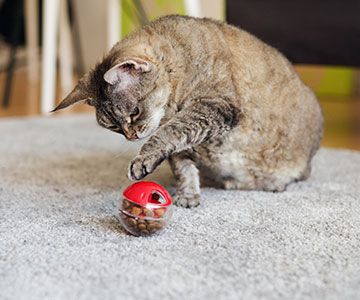
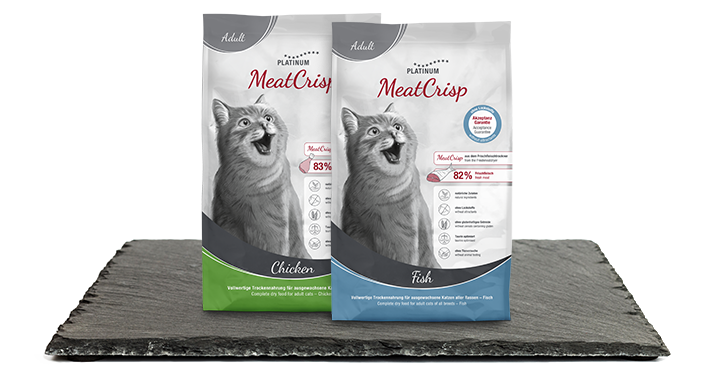
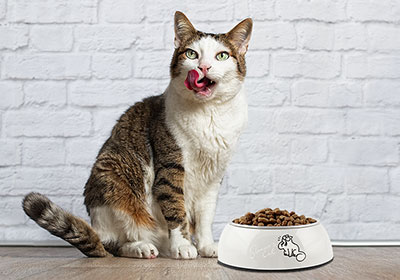
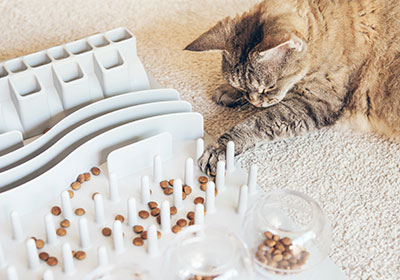
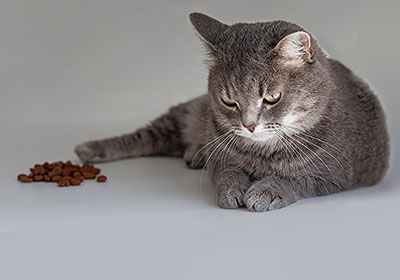
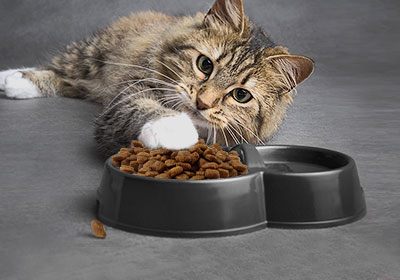
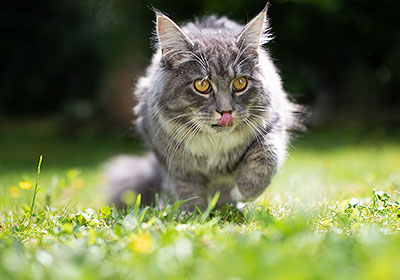
.png)
.png)
.png)
